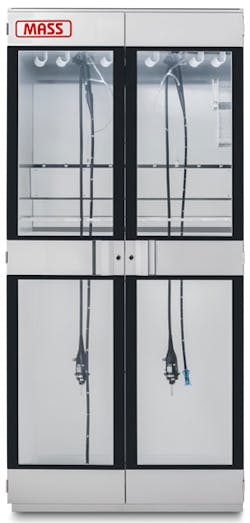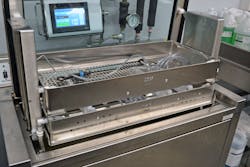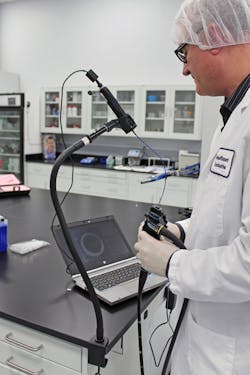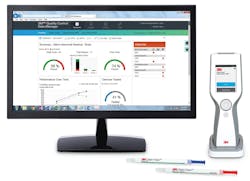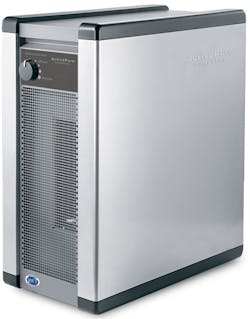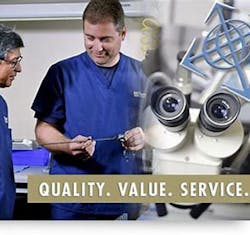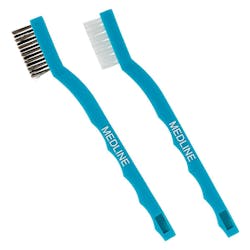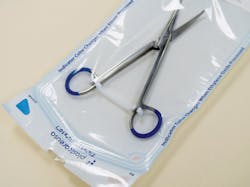Controlling the complexities of decontamination and cleaning
Safe and effective reprocessing of surgical instruments and devices is a series of events involving multiple stakeholders each doing their part in accordance with the item’s instructions for use (IFU). In the February 2022 issue of Healthcare Purchasing News, we highlighted challenges and best practices for point of use cleaning/pretreatment in the operating room (OR) and other procedural areas.
In this article, we turn to the Central Service/Sterile Processing & Distribution (CS/SPD) department, the complexities around decontamination and cleaning, and recommendations on how to make these processes more effective, efficient and safer.
Educating your team
CS/SPD department staff members can only clean items correctly and safely if they have the knowledge to do so.
“[CS/SPD technicians need] education and training, but not just training on the ‘motions’ of reprocessing, also the ‘why,’” said Eric S. Smith, CFER, Infection Prevention & Control Specialist, Medical & Scientific Affairs, Olympus Corporation of the Americas. “Why we do what we do is key to fully understanding the importance of the process.”
“I would recommend reading all 190 pages of ANSI/AAMI ST91:20211 released in early March and discussing the updates with your SPD teams,” Smith added. “Also keep in mind, these recommendations just came out and change doesn’t happen overnight. Evaluate your current processes and see where and what changes should be implemented first and continue to improve your processes to meet these recommendations.”
Confronting complexity
Instruments and devices range from the simple to the increasingly complex and challenging to clean. CS/SPD technicians must be well versed on the manufacturer IFUs for the entire continuum of items that pass through their hands.
“As medical devices are evolving, so are their reprocessing instructions, pushing our sterile processing departments to become more robust and innovative to support these high-tech designs,” said Randalyn Walters, Clinical Manager/Educator, Belimed. “Surgical instruments that are received in the decontamination area face a multitude of cleaning steps, from manual soaking, to intricate brushing techniques, flushing with pressurized water, as well as pressurized air. The steps required to properly manual pre-clean a medical device takes skill, patience, and the proper cleaning tools.”
One critical piece of equipment required for effective and efficient decontamination is an appropriate reprocessing sink, says Walters. Because decontamination is a labor intensive and time-consuming process, the sink should have features that allow for both safe cleaning and the ergonomic safety of CS/SPD staff.
“Allowing for a height adjustable, compliance approved basin sink, with adjustable levers, as well as attachments for flushing, rinsing and pressurized air for drying, really helps the technicians,” said Walters. “There should also be counter space available to use before the soaking period, as well as during the sorting and organization phase.”
To help make the cleaning workflow easier and more efficient for reprocessing staff, Walters also recommends equipment that eliminates the burden of manual flushing with syringes. This could be a pressurized flushing system or properly sized attachments for mechanical means such as an ultrasonic machine.
“Having one of these options takes the burden off technicians completing this process by hand,” said Walters. “An IFU can recommend a particular PSI requirement that cannot be achieved by means of syringes. Utilizing the flush ports and hookup accessories for your mechanical washers and ultrasonic machines can save the technicians time and energy while trying to flush cannulas or lumens.”
To clear up confusion around selecting the proper validated cycle through the mechanical washer disinfector based on a manufacturer’s IFU, Walters recommends the use of washer racks with color coated handles, or some means of labeling, stating:
“This can help departments identify what trays they would like to process together. It allows staff members to continue moving through their workflow, while trays are placed on their corresponding racks, dedicated to particular cycles.”
Getting back to basics
“As simple as this sounds, I’ve recently spent time reintroducing and training on enzymatic soaking in decontamination,” said John Kimsey, VP Operations, Instrument Processing, STERIS. “In our work with multiple hospitals throughout the nation, it has become common to find technicians who immediately start to flush, brush and clean instruments at the beginning of the enzymatic soak.
“We’ve held training sessions to talk through the benefits of allowing the instruments to soak for the full length of time required before starting any manual cleaning efforts,” Kimsey added. “This allows the enzymatic and water to loosen bioburden and improves the efficacy of the cleaning process and reduces retained bioburden.”
Kimsey likens dirty instruments to dirty dishes sitting in a sink for a period of time with ketchup or other food items drying on them. As he explains, trying to scrub off dried-on food without soaking the dish first takes a lot of force and brushing to clean it off. But if the dish is soaked in water for 5 to 10 minutes, it is much easier to remove the food because the water has loosened it.
“We use this example to then talk about bioburden you can’t see inside lumens or other areas of instruments, and how technicians who don’t allow the full soaking time before manual cleaning often times do not spend adequate efforts to remove the dried-on bioburden,” said Kimsey. “If allowed to soak for the required time to loosen the bioburden, their efforts would be more successful. In summary, allow the instruments to soak and let the enzymatic and water solution to do its job before you start any manual cleaning process.”
Identifying issues
For CS/SPD teams looking for ways to improve cleaning efficacy, efficiency and safety, Robert Leenan, Sr. Professional Consultant, Instrument Processing, STERIS, says identifying variation is a good place to start.
“Opportunities can be found in many key areas from hospital operations to leadership tasks and routines,” he said. “One safety example is simply providing easier access to PPE. If non-compliance levels aren’t reduced, take the time to identify the reasons behind the trend. Then you can see if it’s a time issue, a training issue, a supply chain issue, or any number of other reasons. We often start with the basics and advance to more complex issues in a methodical manner. This process helps to ensure improvement to efficacy, efficiency and safety.”
Leenan has seen a renewed focus on lean management techniques in the CS/SPD.
“Experienced and qualified technicians are in short supply,” he said. “In some cases, hospitals utilize lean management techniques and concepts to develop and train staff to become SPD leaders. This can have the long-term benefit of creating lean operational managers that can focus on excellence rather than just trying to maintain the minimum standards.”
STERIS Instrument Processing Solutions (IPS) offers solution-based modules that are specifically designed to improve complex practices and address problems within sterile processing departments. These solution-based modules provide standards and guidance for improving workflow, adhering to regulations, and enhancing the effectiveness of sterile processing activities.
Enhancing visualization
Because it can be extremely difficult, if not impossible, for technicians to see bioburden lingering on instruments and devices, Seth Hendee, CRCST, CIS, CHL, CER, CSPDT, CFER, HSPA Approved Instructor, Clinical Education Coordinator, SPD, Healthmark Industries, stresses the importance of enhanced visualization tools.
“Enhancing visual inspection is the best way to add quality to an SPD’s cleaning processes,” said Hendee. “This can be done in two ways. First, utilizing a borescope to visualize internal spaces that cannot be seen, even with tabletop magnification, will inevitably show any deficiencies in the cleaning process. Second, utilizing a cleaning verification device, (e.g., a swab or flush), to test for residual soils is also an excellent way to determine if those hard to reach/see areas are being effectively cleaned. This is not a new concept, for example, the FDA has cited both methods as ways to increase the safety margin while cleaning joint shavers.”
“While borescopes are not new, the technology continues to improve, and those improvements are worth noting,” Hendee added. “Advances in imaging technology allow borescope catheters to become smaller in diameter and longer length, while still providing detailed images and videos. Another advancement is the ability to change out the imaging catheter. In previous versions, borescopes came in a specific length and diameter. If you needed a different size, the purchase of an entirely different unit was required. Now it is possible to buy a base unit to control the computer/display interface and select/add catheter(s) separately depending on the department’s needs.”
Performing verification
Because some instruments and devices can be challenging to clean, Nikki Kluck, BS, MS, Lead Technical Applications Specialist, 3M, recommends CS/SPD department professionals employ a routine cleaning monitoring program, for example, one that employs Adenosine Triphosphate (ATP) monitoring, to verify the adequacy of the cleaning process.
“With devices and flexible endoscopes in particular, studies have shown that clinical soil can withstand the manual cleaning process and prevent high-level disinfection or sterilization from doing its job2,” said Kluck. “It’s impossible to accurately assess the instrument’s cleanliness with visual inspection alone. As a result, potentially deadly bacteria and pathogens can be passed on to patients.”
Kluck points out how the newly revised ANSI/AAMI ST91:2021 Flexible and semi-rigid endoscope processing in health care facilities (ST91) standard includes a new definition of high-risk endoscopes and requires that all high-risk endoscopes be monitored using cleaning verification tests after each cleaning. Endoscopes that are deemed not to be high-risk are recommended to be monitored with cleaning verification tests when new endoscopes are purchased and at established intervals.
“The 3M Clean-Trace ATP Monitoring System finds residual clinical soil consistently,” Kluck added. “The system uses ATP bioluminescence technology to ‘see’ contaminants. When ATP is combined with the reactants in the Clean-Trace test, light is produced — invisible to the naked eye, but easily read. Results are expressed in Relative Light Units (RLUs), which are representative of the amount of clinical soil on the surface or device.”
Keeping a clean environment
Keeping the decontamination area of the CS/SPD department clean is no easy task as technicians work to remove bioburden from instruments and devices. But Erica Smith, MBA, Surgical Solutions Specialist at Henry Schein Medical emphasizes the importance of the environment on infection prevention.
“One trend that we are closely monitoring is the continued commitment among facilities to maintain proper infection control,” said Smith. “There has been a heightened awareness to monitor the various points in which infections can spread. Now more than ever, facilities are tracking the sterile processing equipment, surfaces, and the air for infections. Staff should keep track of every element within a facility that can affect the spread of infection.”
With regards to tracking environmental elements that can affect the spread of infection, Smith recommends CS/SPD teams create checklists and conduct quarterly trainings.
“Trainings will help staff stay aligned, ensuring they are tracking consistently. With the training should come assessments for the team,” she added.
Maintaining instruments
Reusable instruments and devices, no matter how carefully handled, ultimately suffer from wear. Inspection during each stage of reprocessing, from decontamination through tray assembly and sterilization, can identify items in need of repair.
“A fundamental practice widely accepted throughout the industry is a regularly scheduled instrument/tray maintenance and repair management program,” said Sarah Smith, Manager of Clinical Support Services, Paces MedEquip. “Ensuring instruments are in good working order is critical to successful surgical outcomes.”
Smith says Paces developed one of the first in-house repair labs in 2003 for Mt. Sinai Health System in New York City, and in 2010, expanded its service offering with a focus on mission critical and time sensitive equipment, such as scopes and specialty equipment.
As Smith explains, insulation defects can go unnoticed during simple visual inspections with the naked eye; therefore, Paces has implemented the use of specialized testing equipment.
“As part of our inspection process, we implemented routine dielectric testing of electrosurgical instrumentation to ensure the integrity of the insulation. This testing process is critical to patient safety and the resulting complications that can take place because of tissue burns.”
In 2014, Paces launched its Surgical Onsite Services (SOS) program, designed to improve services and communication between CS/SPD and the OR.
“The SOS program designates full-time technicians onsite who work between the OR and SPD,” said Smith. “We are a conduit for improved communication between these two departments, which must work seamlessly to facilitate key performance tasks to ensure a successful surgical outcome. It’s imperative that they are in sync and work well together.”
Remembering that it starts in the OR
As we covered in the February 2022 issue of Healthcare Purchasing News, this entire journey to clean begins in the operating room (OR), as Hassan Bilal, CRCST, CST, Educational Sales Consultant, Medline Industries, describes:
“There are several practices that can be implemented to improve cleaning, efficiency and safety in the Central Sterile (CS) and Sterile Processing Departments (SPD). One would be an effective point of use cleaning program which starts in the OR and begins the cleaning process of the instrument and continues in decontamination. This improves efficacy, efficiency and safety for the patient. Dirty or soiled instruments can be pre-treated with presoak foam spray while in the OR and transferred to SPD safely and securely in a rigid biohazard container.”
“The presoak foam spray begins the reprocessing process for soiled instruments and the active enzymes of the solution work to break down bioburden on instruments while they are in transport,” Bilal continued. “The presoak foam retains moisture on the instruments for easier removal of soils during reprocessing and Medline’s presoak foam is shown through testing to remain moisturized for up to 72 hours on instruments. Presoak foam and transport containers are ‘newer’ recommendations in the industry as hospitals are under monitoring by the Joint Commission on Accreditation of Healthcare Organizations (JACHO), which checks to ensure surgical instruments are properly transported among other areas of compliance.”
Medline offers a complete portfolio of products designed to enable safe and effective cleaning of surgical instruments, including presoak foam, transport bins, enzymatic detergents, cleaning brushes and neutral detergents.
Stringing in sterilization
When it comes to the opposite end of the reprocessing continuum, sterilization, Shaun Sweeney, Vice President, Cygnus Medical, says one topic that sometimes gets overlooked is the sterilization of ring handled instruments in a peel pouch in the closed position.
“However, a single instrument in a peel pouch doesn’t always get the attention it needs,” he added. “Peel pouches must be sterilized on their edges, where gravity naturally causes the instrument to close during handling. The same science followed in a closed or wrapped tray of instruments still applies to single instruments traveling in a peel pouch. Having a versatile, easy to use solution can help create a more consistent efficacy.”
References:
1. ANSI/AAMI ST91:2021: Flexible and Semi-rigid Endoscope Processing in Health Care Facilities.” Association for the Advancement of Medical Instrumentation. Published March 1, 2022
2. Rutala WA, Weber DJ. In: Healthcare Infection Control Practices Advisory Committee (HICPAC). Guideline for disinfection and sterilization in healthcare facilities, Vol 2012. Washington [DC]: Department of Health and Human Services; 2008.

Kara Nadeau | Senior Contributing Editor
Kara Nadeau is Sterile Processing Editor for Healthcare Purchasing News.

